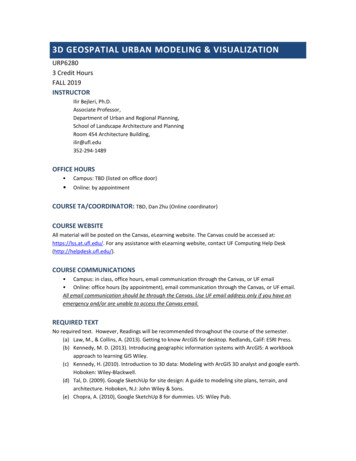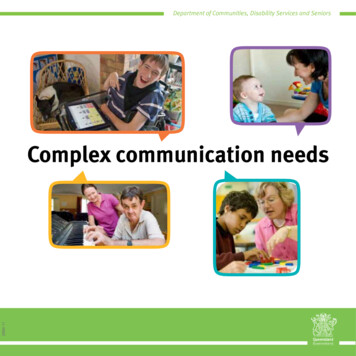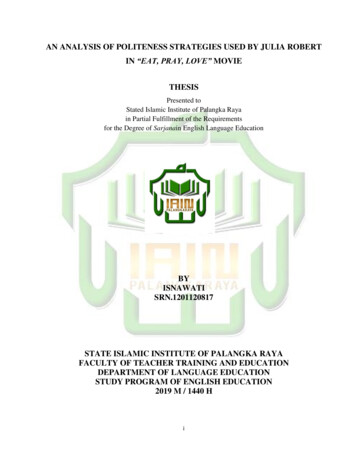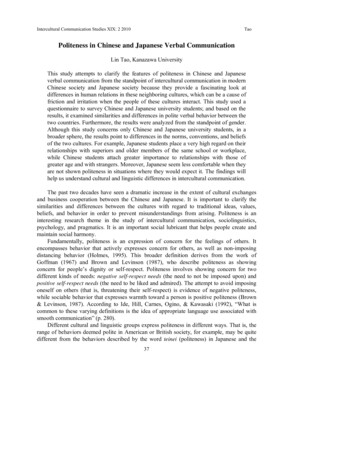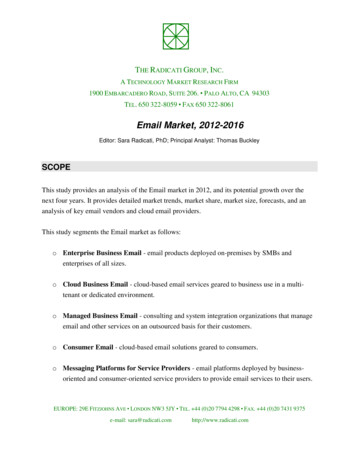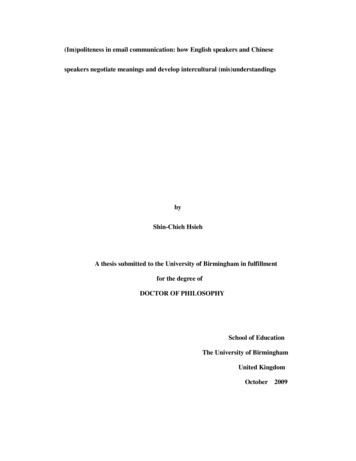
Transcription
(Im)politeness in email communication: how English speakers and Chinesespeakers negotiate meanings and develop intercultural (mis)understandingsbyShin-Chieh HsiehA thesis submitted to the University of Birmingham in fulfillmentfor the degree ofDOCTOR OF PHILOSOPHYSchool of EducationThe University of BirminghamUnited KingdomOctober 2009
University of Birmingham Research Archivee-theses repositoryThis unpublished thesis/dissertation is copyright of the author and/or thirdparties. The intellectual property rights of the author or third parties in respectof this work are as defined by The Copyright Designs and Patents Act 1988 oras modified by any successor legislation.Any use made of information contained in this thesis/dissertation must be inaccordance with that legislation and must be properly acknowledged. Furtherdistribution or reproduction in any format is prohibited without the permissionof the copyright holder.
AbstractThe purpose of this thesis is to investigate how people from different backgroundsnegotiate meanings in interactions. In particular, this study looks at the way in whichChinese and English speakers employ (im)politeness strategies in their emails todevelop intercultural understanding. From a theoretical perspective, this thesiscontributes to the discussions of intercultural communication in relation to thenegotiation of (im)politeness meaning. From a pedagogic perspective, the thesisreveals the potential for using email to experience culture as a process of meaningnegotiation and construction and has relevance to teachers of EFL in Taiwan and otherlanguage teaching contexts.In an attempt to investigate discursively the negotiation of meaning in emailinteraction, ethnographically-informed discourse analysis is employed. It considerssuch issues as the role of email technology, the cultural background of participantsand other contextualised factors in creating intercultural (mis)understandings. Theinterplay between the computer-mediated communication, speech acts and(im)politeness are explored by using the analytical frameworks of Hymes’ethnography of communication, Searle’s speech act theory (1969) and Brown andLevinson’s politeness theory (1987).This research shows that ‘(im)politeness’ is not a stable construct. Rather, it isconstantly (re)negotiated by the interactants, who take into account the relevantcontextualisation cues. It finds that the functions and (im)politeness meanings ofspeech acts can vary from situations to situations. The interactants’ interpretations ofan act can be influenced by the collective references drawn from their pastinteractions, which include the norms of interactions, interpersonal relationships, andthe interactants’ background information. In this sense, the linguistic meaning of anact does not always correspond to its actual meaning in a context. In addition, thisresearch finds that the computer-mediated paralanguages, such as emoticons andwritten out laughter, are also important in realising (im)politeness intent anddeveloping intercultural understanding in emails.This thesis ends with possibilities for implementing email in language teaching andlearning. It is suggested that email provides opportunities for language learners toexperience the pragmatic aspects of language use in interactions and developintercultural understanding through the process of email correspondences with peoplefrom different backgrounds. This thesis also proposes further research on thepragmatic functions of the paralinguistic cues in computer-mediated communication.i
AcknowledgementsMy PhD study has been a long journey. During the journey, many people havesupported me and helped me through the ups and downs.First, I am greatly indebted to my supervisor, Professor Angela Creese for herintellectual guidance and comments. Her encouragements and inspirations kept megoing when I encountered difficulties. Those countless meetings with her have beenthe most intellectual and warm memories during my study. She is my mentor, my rolemodel and also my friend.I am very grateful to Professor Helen Spencer-Oatey and Dr. Sheena Gardner for theirinsightful comments on this thesis. I would also like to express my gratitude to theparticipants who took part in this study. Their time and efforts have made this thesispossible. I have learnt a lot from them and I will always be grateful to them.My deepest love and gratitude go to my parents and brother. They have alwayssupported me in every way and have shown great faith in me. They share myhappiness as well as my sadness. Because of their unconditional love, I can pursue mydreams without hesitation. This thesis is dedicated to them.I would also like to thank Vic Chang. Without him, I could never have survived thedifficult times in writing this thesis. He has always been there for me and I feel that hestood in my shoes to share my feelings. I cannot imagine having taken this journeywithout him. His complete support and love will always be something that I cherish.Finally, the University of Birmingham gave me wonderful experience in my study.The friendly and encouraging academic community has added great memories to mylife in the UK. I am and will always be proud of being a member of this university.ii
Table of ContentsAbstract .iAcknowledgements iiTable of contents . iiiList of Figures and Tables .ixList of Excerpts .xList of Abbreviations and Acronyms .xiChapter 1 : Introduction1.1 Background and motivations 11.2 Research aims and questions 41.3 An overview of the research project .71.4 The context of the study .91.4.1 Intercultural communication via email 91.4.2 The context of the research project 111.5 Overview of the thesis 13Chapter 2 : Literature Review2.1 Introduction 152.2 Intercultural communication .172.2.1 What is ‘culture’ .172.2.2 Intercultural communication .242.2.3 Intercultural computer-mediated communication .272.3 Speech act theory 292.3.1 Review of speech act theory 302.4 Politeness 382.4.1 Politeness theory. .382.4.1.1 Politeness Rules - Robin Lakoff .392.4.1.2 Politeness Principles - Geoffrey Leech .412.4.1.3 Politeness Theory – Penelope Brown & Stephen Levinson .422.4.2 Criticisms of Brown and Levinson’s politeness theory .482.5 Modifying Brown and Levinson for this research .552.6 (Im)politeness in online communication 612.7 Summary. 64iii
Chapter 3 : Methodology3.1 Introduction 663.2 Methodology and approach 663.2.1 Discussion of methodology .663.2.2 Ethnographically informed discourse study 693.2.2.1 Traditional ethnography .703.2.2.2 Ethnographically informed discourse study .743.3 Research design .773.3.1 Research design based on the Internet 783.3.1.1 Research procedure .813.3.2 Recruitment 843.4 Data collection 913.4.1 Discourse Completion Test .923.4.2 Web-page-based survey .943.4.3 Email entry .963.4.4 E-journal .973.4.5 E-interviewing 993.5 Data analysis 1043.5.1 Analytical framework 1043.5.2 Data analysis- ethnographically informed discourse analysis .1083.6 Ethical considerations .1153.7 Summary .118Chapter 4 : Data analysis I4.1 Introduction . 1204.2 Pair 1- The event of 9/11 .1224.2.1 Participants’ profiles 1224.2.2 Communicative events 1224.2.3 Ed’s analysis .1264.2.3.1 Ed’s speech act analysis .1264.2.3.2 Ed’s (im)politeness strategies analysis .1284.2.4 Keith’s analysis .1314.2.4.1 Keith’s speech act analysis .1314.2.4.2 Keith’s (im)politeness strategies analysis .1344.2.5 Discussion .139iv
4.3 Pair 2 – Proposing 1414.3.1 Participants’ profiles 1414.3.2 Communicative events 1414.3.3 Chloe’s analysis .1434.3.3.1 Chloe’s speech act analysis 1434.3.3.2 Chloe’s (im)politeness strategies analysis .1454.3.4 Matthew’s analysis .1474.3.4.1 Matthew’s speech act analysis 1474.3.4.2 Matthew’s (im)politeness strategies analysis .1494.3.5 Discussion .1514.4 Pair 3 – Interview advice .1544.4.1 Participants’ profiles 1544.4.2 Communicative events 1544.4.3 Sherry’s analysis .1564.4.3.1 Sherry’s speech act analysis .1564.4.3.2 Sherry’s (im)politeness strategies analysis .1594.4.4 Andy’s analysis 1604.4.4.1 Andy’s speech act analysis .1604.4.4.2 Andy’s (im)politeness strategies analysis .1634.4.5 Discussion .1664.5 Conclusion for Chapter 4 . 169Chapter 5 : Data analysis II5.1 Introduction .1705.2 Pair4 – Dieting .1705.2.1 Participants’ profiles 1705.2.2 Communicative events 1715.2.3 Eve’s analysis .1725.2.3.1 Eve’s speech act analysis 1725.2.3.2 Eve’s (im)politeness strategies analysis .1745.2.4 May’s analysis .1775.2.4.1 May’s speech act analysis .1775.2.4.2 May’s (im)politeness strategies analysis 1795.2.5 Discussion .181v
5.3 Pair5 – A relationship issue .1855.3.1 Participants’ profiles 1855.3.2 Communicative events 1855.3.3 Jane’s analysis 1875.3.3.1 Jane’s speech act analysis .1875.3.3.2 Jane’s (im)politeness strategies analysis 1895.3.4 Helen’s analysis .1915.3.4.1 Helen’s speech act analysis 1915.3.4.2 Helen’s (im)politeness strategies analysis .1925.3.5 Discussion .1955.4 Pair6 – Offensive questions .1975.4.1 Participants’ profiles 1975.4.2 Communicative events 1975.4.3 Joy’s analysis .1995.4.3.1 Joy’s speech act analysis 1995.4.3.2 Joy’s (im)politeness strategies analysis .2035.4.4 Doris’ analysis .2075.4.4.1 Doris’ speech act analysis .2075.4.4.2 Doris’ (im)politeness strategies analysis 2095.4.5 Discussion .2125.5 Conclusion for Chapter 5. . .214Chapter 6 : Data analysis III6.1 Introduction .2166.2 Pair7 – A near accident .2166.2.1 Participants’ profiles 2166.2.2 Communicative events 2176.2.3 Penny’s analysis .2186.2.3.1 Penny’s speech act analysis 2186.2.3.2 Penny’s (im)politeness strategies analysis .2216.2.4 Peter’s analysis 2256.2.4.1 Peter’s speech act analysis .2256.2.4.2 Peter’s (im)politeness strategies analysis .2266.2.5 Discussion .229vi
6.3 Pair 8 - Avoiding political topics .2326.3.1 Participants’ profiles 2326.3.2 Communicative events 2326.3.3 Nelson’s analysis .2346.3.3.1 Nelson’s speech act analysis .2346.3.3.2 Nelson’s (im)politeness strategies analysis 2366.3.4 Calvin’s analysis .2376.3.4.1 Calvin’s speech act analysis .2376.3.4.2 Calvin’s (im)politeness strategies analysis 2396.3.5 Discussion .2406.4 Pair 9 - Apologising for the long email .2436.4.1 Participants’ profiles 2436.4.2 Communicative events 2436.4.3 Bill’s analysis .2446.4.3.1 Bill’s speech act analysis 2446.4.3.2 Bill’s (im)politeness strategies analysis .2476.4.4 Roger’s analysis .2506.4.4.1 Roger’s speech act analysis 2506.4.4.2 Roger’s (im)politeness strategies analysis .2526.4.5 Discussion .2556.5 Conclusion for Chapter 6 .257Chapter 7 : Synthetic discussion7.1 Introduction .2597.2 Table summary .2597.2.1 Expressive speech act 2637.3 Discussion based on the research questions .2647.4 Final remarks 286Chapter8 : Final Remarks8.1 Introduction .2888.2 Summary of the thesis .2888.3 Limitations of the study 2948.4 Implications for teaching language and culture .2998.5 Conclusions .304References . 309vii
List of AppendicesAppendix1 Recruitment notice for Chinese speakers .339Appendix2 Recruitment notice for English speakers .341Appendix3 Informed-consent form 343Appendix 4 Pre-survey questionnaire 345Appendix 5 Discourse Completion Test as an icebreaker. 346Appendix 6 Examples of e-journals .347Appendix 7 Examples of e-interviews. .349Appendix 8 Example of the complete email correspondences. 351Appendix 9 Prompts for e-journals 365viii
List of Tables and FiguresFigure 2.1: Conceptual framework of intercultural communication via email 16Figure 2.4: Circumstances determining choice of strategy .45Figure 8.1: The theoretical and methodological frameworks of the research 291Table 2.2: Culture paradigm . .20Table 2.3: Searle’s Speech Act Taxonomies 33Table 2.5: Emoticons 63Table 3.1: Research Procedure .83Table 3.2: Participants’ profiles 89Table 3.3: The numbers of e-interviews with each participant .103Table 3.4: Analytical framework 111Table 3.5: The communicative event of each pair .113Table 4.1: The arrangement of the data analysis chapters .121Table 6.1: Animated emoticons .242Table 7.1: Table summary of each communicative event .261ix
List of ExcerptsExtract AExtract BExtract CExtract DExtract EExtract FExtract GWeek 6 Ed to Keith .124Week 6 Keith to Ed .125Week11 Chloe to Matthew 142Week 11 Matthew to Chloe .142Week11 Chloe to Matthew 143Week 11 Matthew to Chloe .143Week 3 Sherry to Andy .156Extract HExtract IWeek 4Week 4Extract JExtract KExtract LExtract MExtract NWeek4 May to Eve .171Week 6 Jane to Helen .186Week 6 Helen to Jane .186Week7 Jane to Helen .186Week10 Joy to Doris .198Extract OExtract PExtract QExtract RExtract SExtract TExtract UExtract VExtract WWeek11Week11Week 6Week 6Week 5Week5Week3Week4Week5Andy to Sherry .156Eve to May .171Joy to Doris .198Doris to Joy .199Penny to Peter .217Peter to Penny .218Nelson to Calvin .233Calvin to Nelson .234Bill to Roger .244Bill to Roger .244Roger to Bill .244x
List of Abbreviations and AcronymsCMCComputer-mediated communicationCPCooperative principleDCTDiscourse Completion TestFTAFace-threatening actFTFFace-to-FaceICIntercultural communicationIPIrony principlePPPoliteness principleHHearSSpeakerxi
Chapter 1Introduction1.1 Background and MotivationThe purpose of this chapter is to introduce the rationale behind this research andpresent the research aims of this study. This thesis aims to describe and analyseintercultural communication between Chinese and English speakers via email.With the advent of the Internet, the opportunities for people from differentlocations to interact have greatly increased. Computer-mediated communication hastranscended geographical boundaries and time differences and allowed people fromdifferent countries to interact and communicate with little or no hassle. Thecomputer-mediated form of communication has significantly impacted on today’sworld. People make friends in online chat rooms, do business via email, searchinformation or play online games with people from the other end of the world. Allthese online activities have become a very important part of our everyday life.People no longer need to travel a long way to another country in order to interactwith the local people. Intercultural communication, therefore, is drawing more andmore attention. Acknowledging the increasingly important role of interculturalcommunication in today’s world, the Ministry of Education in Taiwan has specificallymade it one of the 2009-2012 educational goals to broaden students’ horizons andunderstanding of the world. The educators in Taiwan recognise the need to preparestudents for the globalised and multicultural environment. However, Grosse(2002:22-23) points out that “learning how to handle the technology and dealing withdifferent cultures can pose the biggest challenges.” This is to say that the conveniencebrought by the computer-mediated communication does not guarantee effectiveintercultural communication. Thus, it is worth exploring what constitutes a successful1
intercultural communication mediated by the new technology.Spitzberg (1988) points out that “[c]ompetent communication is interaction thatis perceived as effective in fulfilling certain rewarding objectives in a way that is alsoappropriate to the context in which the interaction occurs” (p.68). In simple terms, aneffective intercultural communication calls for the interactants’ awareness of what isappropriate and inappropriate in the context. Hence, this thesis attempts to explore theinterplay of computer-mediated communication and intercultural understanding.Even though this research does not specifically aim to test students’ language andintercultural competence, it wishes to consider the pedagogic possibilities of usingcomputers to raise intercultural awareness. For this reason, this research set up anintercultural communication project which invited Chinese and English speakers toexchange emails. It aimed to explore how intercultural understandings betweenChinese and English speakers were developed via email. Chinese and Englishspeakers were chosen to be the focus of this research because this setup reflects thetypical pedagogical arrangements for teachers in Taiwan wanting their students tocome into contact with English speakers. Even though at the beginning the Chineseand English speakers, who did not know each other, were paired up by me, theirinteractions were entirely their own. The research project design will be explained infurther detail in the methodology chapter.In the research project, I was interested in the meaning negotiation between theparticipants’ in their emails. To be more specific, the online interculturalcommunication in this study involves various concepts important in language teachingleaning, namely ‘culture’, ‘communication’, ‘computer-mediated communication’ and‘language use’ (see Literature Review). In other words, knowledge of interculturalcommunication can be further understood through the investigations of people’s email2
interactions.The negotiation of meanings between the interactants is explored byinvestigating the speech acts and (im)politeness strategies in the pairings’ emailcorrespondence. The discursive analysis of meaning negotiation takes into account therelevant factors, such as topic, norms of interaction, relationship, interactants’backgrounds and considers the interrelationships between interactants (see Hymes,1974). Thus, this thesis is interdisciplinary in the sense that it works within thespecific theoretical framework of the ethnography of communication, interculturalcommunication and computer-mediated communication while performing linguisticand discourse analyses using speech act and politeness theory.Although intercultural communication has been investigated in many empiricalstudies, little work has been carried out on the rules of appropriateness in e-mailcommunication (cf. Hymes, 1971). The notion of politeness to interculturalcommunication is significant because “in studying politeness, we are automaticallystudying social interaction and the appropriacy of certain modes of behaviour inaccordance with socio-cultural conventions” (Watts, Ide & Ehlich, 1992: 6). Whileagreeing with Watts et al., I also consider the study of politeness is a useful means ofunderstanding how people from different national backgrounds regulate socialinteraction via email and negotiated intercultural (mis)understanding during theinteractions. The negotiation of face between the interactants links basic face needs toexplicit (im)politness strategies with consideration of the cultural, social and specificcontext of the interaction. In order to tackle the complexity of interculturalcommunication and computer-mediated communication, ethnographically-informeddiscourse analysis is introduced (see Chapter 3). The research design contributes tothe knowledge of how an ethnographic approach can be used for email discourse.3
From a theoretical perspective, this thesis contributes to the discussions ofintercultural communication in relation to the negotiation of (im)politeness meaning.From a pedagogic perspective, it is my intention to explore how culturalunderstanding can be negotiated by the exchange of emails. It is hoped that theinsights gained from the participants’ meaning making processes could contribute tothe understanding of intercultural communication and inform EFL practitioners whowish to increase learners’ intercultural awareness by using email interculturalexchanges in their pedagogy and curriculum.1.2 Research aims and research questionsThis research aims to gain understanding about how polite and impolite s.Theinterplaybetweencomputer-mediated communication, culture and language is explored by unpackingthe meaning of (im)politeness carried out in speech acts.The meaning of (im)politeness in this research is explored by means of suchqualitative data as pre-survey questionnaire, email exchanges, e-journals ande-interviews. By carrying out an ethnographically-informed discourse analysis of theparticipants’ email correspondence, this research attempts to “look beyond the texts ofinteraction to the broader contextual dynamics that shape and are shaped by thosetexts” (Warschauer & Kern, 2000, p. 15). In other words, it intends to explore themeaning in the participants’ emails not only by analysing the syntactic construction ofthe email sentences, but it also looks at the relevant factors which come to influenceand/or form the intended meaning in the sentence, such as the interactants’relationship, norms of interaction and topic.4
The aims of the research are listed below:1.To demonstrate how Chinese and English speakers carry out their interculturalcommunication via email.2.To identify the elements which influence the development of interculturalunderstanding in emails.3. To show how the meaning of (im)politeness is formed, negotiated and transmittedvia email.In light of the research aims, the specific questions addressed by the thesis arepresented below.1. What is the content and themes covered in e-mail exchanges between the speakersof Chinese and English in this intercultural email communication project?This question aims to find what topics and information are discussed in theparticipants’ email correspondence. Unlike face-to-face interaction, the participants’gender, age and physical appearances are not immediately apparent in their emailinteractions. Thus, I wish to see how the participants begin to know one another asindividuals who are native to another country. In addition, by looking at the content ofthe email interaction, I wish to see how they form understandings of the otherperson’s background, such as family, hobbies, likes, dislikes, interests, education orcultural values. Since this is an ethnographically-informed discourse study, it isessential for me to form interpretations based on the investigation of rich and in-depthdata. Thus, the information obtained about the participants could be used as the focusof the analysis, or it could also be used as additional references to support the dataanalysis.5
2. What are the salient speech act(s) emerging in the communicative events and howare they used to negotiate the communicative goals?The answers to this question are important for the following reasons. First, speech actsare considered as the basic unit of investigation of a communication (see Austin 1962;Searle, 1969; 1975). The linguistic analysis of speech acts could provide opportunitiesto allow patterns, if any, to be revealed during interactions. More importantly, inanalysing the speech acts performed in a particular context, it is hoped that morecontextualised explanations of the functions of speech acts can be provided. Thecontextualised understanding of the speech acts could reveal language function(s) in agiven context. The answer to this question may thus be useful in clarifying the factorswhich could influence or even change the function of speech acts. Second, since theinteraction between participants will take place in the email system, thecomputer-mediated features of email which associate with the writer’s linguisticperformance must also need to be taken into account. In addition, I am interested tosee how computer-mediated features such as emoticons and animations, if any, workin email intercultural communication.3. How does the meaning of (im)politeness manifest itself in intercultural emailcommunication?Email interaction is different from real time face-to-face interaction in that it lacks thelatter’s non-verbal cues (i.e. facial expression, tone, gesture). Thus, I am interested tofind how the interactants negotiate their (im)politeness meaning with each other intheir email interactions. Furthermore, I would also like to find out whatcomputer-mediated features are employed in the email exchanges in order to formintercultural understanding.6
4. To what extent can email contribute to the intercultural communication andunderstanding?Fundamentally, this question is intended to find how email could contribute to thedevelopment of intercultural awareness in foreign language education, which isclosely related to the research goal. The asynchronous nature of email interculturalcommunication allows time for the participants to compose their responses. Could itbecome an advantage for language learners as they establish their understanding ofpeople from another country? This question seeks answers from the observations ofthe participants’ emails and collections of feedback from their e-journals ande-interviews.1.3 An overview of the research projectFor this research project, nine Chinese speakers from Taiwan and nine Englishfrom America and Britain exchanged emails for a period of three months. During theproject time, other qualitative data were collected, namely the pre-surveyquestionnaires, e-journals and e-interviews. The data were analysed primarily on thebasis of the theoretical frameworks of speech act theory (Searle, 1969) and politenesstheory (Brown & Levinson, 1987) with some additional references to other relatedempirical studies.The investigation of email interactions also considered issuessuch as the role of this particular mediating technology (email), the culturalbackground of participants and other contextual factors.This research proposes to investigate how intercultural understanding is formedin interactions. It is my view that culture, communication and language areinterrelated elements. They are of equal importance in this interculturalcommunication research. In this sense, culture involves the embedded values which7
may or may not influence people’s online communication and language performance.Thus culture is not considered as a static notion, but a concept emerging in theinterplay between cultural values, communication and language display. Based on thisconceptualisation of culture, the only way to gain more in-depth understanding of themeaning of culture is through the investigation of the actual interactions. Rampton etal. (2004:2) also propose that the close analysis of language use reveals “bothfundamental and distinctive insights into the mechanisms and dynamics of social andcultural production in everyday activity.” In line with this view, I want to unpack theprocess of meaning formations through the investigations of the participants’ emailcorrespondences.The pragmatic aspect of lang
develop intercultural understanding. From a theoretical perspective, this thesis contributes to the discussions of intercultural communication in relation to the negotiation of (im)politeness meaning. From a pedagogic perspective, the thesis reveals the potential for using email to experience culture as a process of meaning
